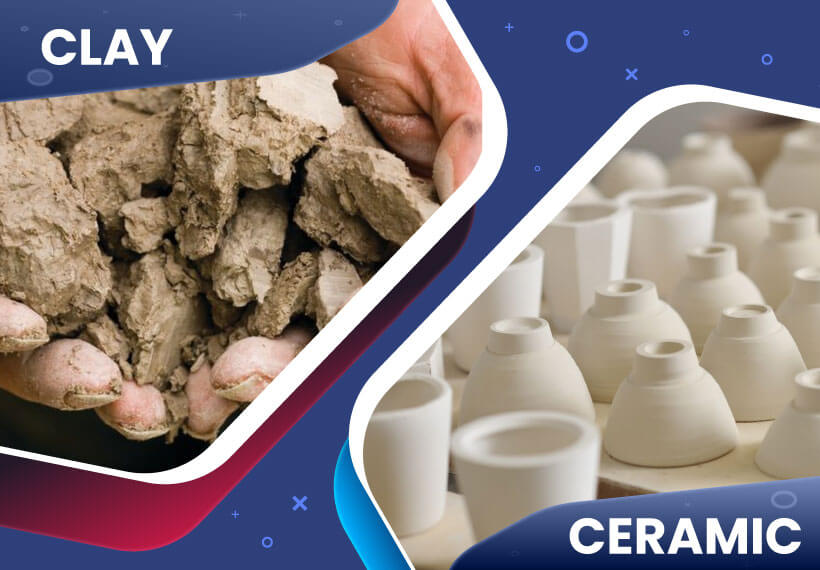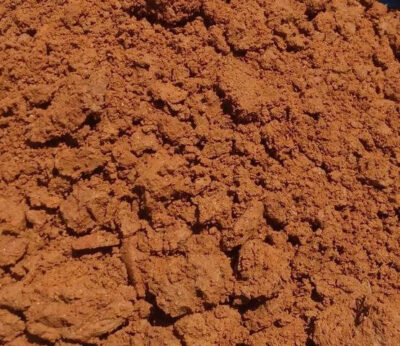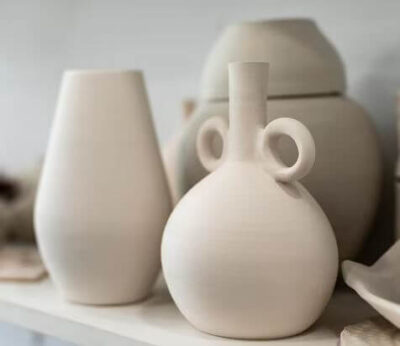Clay vs. Ceramic: Which is Better?

Understanding the differences between clay and ceramic can be essential when working with either material, whether you are just beginning your ceramic art journey, or looking to add tiles into your living space.
Gaining a better understanding of these materials is the first step toward making informed decisions.
“Clay” and “ceramic” are often used interchangeably in art, construction, and pottery circles; however, their definitions differ significantly.
To fully appreciate and harness their potential as versatile materials, we must understand their fundamental differences; in this comprehensive guide, we will outline these distinctions while discussing the compositional, physical, and application details of both.
Difference Between Clay and Ceramic
Clay: The Earth’s Versatile Material

What is Clay?
Clay is an all-natural earthen material composed of fine minerals and organic matter that offers unique plasticity and malleability, making it an essential raw material in numerous industries.
Types of Clay
Different varieties of clay are available today, such as kaolin, ball clay, and fire clay, all possessing distinct properties and applications.
Natural Occurrence
Clay can be found throughout nature, often near riverbanks or deposits, where its formation results from weathering processes or geological forces.
Properties of Clay
Clay boasts qualities like plasticity, cohesion, and absorption, making it popular in pottery making, construction projects, and skincare products.
Ceramic: Transforming Clay into Art and Utility

What is Ceramic?
Ceramics is the end product produced when clay is fired at high temperatures to undergo significant transformation in its manufacturing.
The Ceramics Process
Making ceramic masterpieces begins with turning raw clay into something durable yet beautiful through shaping, drying, and firing.
Types of Ceramics
Ceramic products span an expansive spectrum, from decorative art pieces to functional items like kitchenware, tiles, and aerospace components.
Characteristics of Ceramic
Ceramics have superior hardness, heat and corrosion resistance, and an appealing aesthetic compared with raw clay products.
Composition: Clay and Ceramic
Clay Composition
Clay is composed largely of hydrated aluminum silicate minerals that vary in composition depending on its properties and form. These elements combine to produce the distinctive properties that make up most clay deposits.
Ceramic Composition
Ceramics, on the other hand, are formed by fusing clay with various additives to alter and enhance its chemical structure and increase its properties.
Key Variations
Fluxes, fillers, and binders are integral in creating distinctive ceramic products with distinct properties and characteristics.
Formation and Firing: The Crucial Transformation
Clay Formation
Clay forms naturally through the weathering of rocks, while geological forces shape its properties and properties.
Ceramic Formation
Ceramics undergo an inexorable transformation through shaping, drying, and firing in high-temperature kilns.
Firing Process
Firing is the foundational step in ceramic production, solidifying their structures and improving durability.
Properties and Uses
Clay’s Properties and Uses
Clay can be utilized in pottery making, construction projects, agriculture, and skincare due to its plasticity and absorbent qualities.
Ceramic’s Properties and Uses
Ceramics excel in industries demanding hardness, heat resistance, and aesthetic appeal – such as kitchenware, tiles, and high-tech industries.
Overlapping Applications
Certain applications, like earthenware pottery, blur the distinctions between clay and ceramics by showcasing their versatility.
Strength and Durability: A Battle of Materials
Clay’s Strength
Clay may be malleable but lacks the strength of ceramics when exposed to stress, leading it to crack or break under pressure.
Ceramic’s Strength
Ceramics possess exceptional strength, making them suitable for applications where long-term performance and durability are of great importance, such as aerospace components.
Comparative Durability
Ceramic materials excel when resisting wear and tear, such as in industries with demanding production requirements or where wear resistance is critical.
Moldability and Craftsmanship: Artistic Implications
Clay in Art and Craft
Clay’s adaptable qualities and effortless shaping capabilities have long made it a favorite medium among artists and craftspeople worldwide.
Ceramic Artistry
Ceramic artists use this transformative process to craft intricate yet durable works of art, from delicate porcelain to robust stoneware.
Crafting Possibilities
Clay and ceramics offer artists many avenues for artistic expression; however, their characteristics differ significantly when produced as finished products.
Color and Finish: From Earthy Tones to Glazing Brilliance
Natural Clay Colors
Clay comes in various natural hues that depend on its mineral makeup and region of origin, lending earthy tones to any designs created from it.
Ceramic Color Options
Ceramic artists enjoy creating vibrant and glossy finishes by applying colors through glazing techniques to ceramic pieces.
Glazing Techniques
Glazing ceramic pieces is an art unto itself, allowing ceramicists to add protection and style to their works of art.
Cost Considerations: Balancing Budgets
The Cost of Clay
Raw clay tends to be more affordable, making it accessible for hobbyists and smaller-scale projects.
Budgeting for Ceramics
Ceramics may be more costly due to additional processing steps and firing, yet their long-term investment justifies any other expenditures.
Economic Factors
Decisions between clay and ceramics often depend on budgetary concerns and intended uses for each material.
Environmental Impact: Sustainability Matters
Clay’s Environmental Impact
Clay mining may cause environmental disruptions; however, its plentiful supplies could reduce some concerns.
Ceramic Sustainability
Ceramic production has evolved to reduce environmental impact through eco-friendly practices and recycling initiatives.
Eco-Friendly Choices
Eco-minded consumers can reduce their ecological impact by purchasing sustainable clay or ceramic products.
Maintenance and Care: Keeping Clay and Ceramics Pristine
Caring for Clay Artifacts
Clay items should be handled carefully to prevent decomposition by moisture and degradation and to preserve their value over time.
Ceramic Maintenance
Ceramics may be durable but still need special care to preserve their beauty and functionality.
Longevity Tips
Proper maintenance practices can extend the longevity of both clay and ceramic items.
Historical Significance: Tracing the Origins
Historical Uses of Clay
Clay has been essential to human civilization for millennia – from pottery making to ancient architecture.
Ceramics through the Ages
Ceramics have left an indelible mark on archaeological records, showcasing craftsmanship’s evolution.
Artifacts and Archaeology
Clay and ceramic artifacts provide invaluable insight into past cultures and technological development.
Cultural Significance: Symbolism and Tradition
Clay in Culture
Clay has long been revered in numerous cultures worldwide as it often represents creation, fertility, and connection to our Earthly home.
Ceramics in Tradition
Ceramics are invaluable in cultural ceremonies – from Chinese porcelain to Native American pottery, they all hold significance for different groups and religions.
Cultural Symbols
Clay and ceramics both possess profound symbolism that conveys their cultural importance worldwide.
Innovation and Modern Applications: Beyond Tradition
Clay’s Contemporary Uses
Clay has long been used in cutting-edge fields; thanks to advances in 3D printing and nanotechnology, it has even greater applications in cutting-edge areas.
Modern Ceramic Innovations
Ceramic materials advance rapidly, finding applications in aerospace, healthcare, and electronics.
Technological Advancements
Material science advances have broadened the horizons of what ceramics and clay can do in today’s society.
Frequently Asked Questions (FAQs)
Are porcelain products considered clay or ceramics?
Porcelain is a type of ceramic material with high thermal conductivity that is vitrified at high temperatures.
Are ceramics suitable for pottery making?
Pottery is made using clay, which can be transformed into ceramics through firing.
Are ceramics more environmentally friendly than clay?
How eco-friendly clay and ceramic products depend heavily upon their sourcing and production methods; sustainable practices may make both clay and ceramic options suitable as eco-friendly choices.
Which material is better for creating sculptures: clay or ceramics?
Clay’s malleability makes it popular with sculptors, while ceramics provide long-term outdoor durability.
What are some notable historical clay and ceramic artifacts?
Examples include Terracotta Army (clay) and Ming Dynasty porcelain (ceramic).
Explore clay and ceramics as you investigate their unique attributes, noting how they enrich lives through art, architecture, and craftsmanship.
Conclusion
Clay and ceramics share their origin in earthenware pottery production; however, their composition, strength, aesthetics, applications, and design vary significantly, as do their flexibility, traditionalism, innovation, and longevity characteristics.
By understanding their distinct differences, we can capitalize on each material’s advantages while appreciating their contributions to art, construction, and culture.

